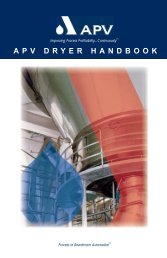A Comparative Study Between Tablet and Laptop PCs: User ... - Umbc
A Comparative Study Between Tablet and Laptop PCs: User ... - Umbc
A Comparative Study Between Tablet and Laptop PCs: User ... - Umbc
You also want an ePaper? Increase the reach of your titles
YUMPU automatically turns print PDFs into web optimized ePapers that Google loves.
<strong>Tablet</strong> PC <strong>User</strong> Satisfaction <strong>and</strong> Preferences 331<br />
This comparative study aims at determining user attitudes concerning <strong>Tablet</strong><br />
<strong>PCs</strong>, how they are perceived as a mobile computing medium that is radically different<br />
from others, <strong>and</strong> eventually determining the potential of <strong>Tablet</strong> <strong>PCs</strong> in<br />
meeting all computing needs of users.<br />
Refining the aforementioned general research questions, this study focuses on<br />
usability with respect to common computing tasks on <strong>Tablet</strong> <strong>PCs</strong> in a comparative<br />
manner. Several tasks are used <strong>and</strong> studied to compare different media (<strong>Tablet</strong><br />
<strong>PCs</strong>, laptop <strong>PCs</strong>, <strong>and</strong> pen <strong>and</strong> paper), followed by questionnaires measuring comfort<br />
levels, perceived convenience, <strong>and</strong> mobility, among others, of the <strong>Tablet</strong> <strong>PCs</strong>.<br />
<strong>User</strong> performance was also measured as part of this study but is briefly discussed<br />
because of the satisfaction <strong>and</strong> preference focus.<br />
A variety of tasks are routinely performed by computer users. To exactly<br />
underst<strong>and</strong> the usability preference <strong>and</strong> satisfaction issues among <strong>Tablet</strong> <strong>PCs</strong>,<br />
laptop <strong>PCs</strong>, <strong>and</strong> pen <strong>and</strong> paper, a representative set of tasks had to be chosen. For<br />
this purpose, four main tasks were chosen that are most commonly performed on<br />
computers: reading comprehension, typing/writing, direct manipulation, <strong>and</strong><br />
form filling. All these tasks are also commonly used when users are on the Web<br />
(Ozok & Salvendy, 2000). It was concluded that allowing users to perform these<br />
types of tasks would result in the accurate <strong>and</strong> representative measurement of<br />
their preferences <strong>and</strong> satisfaction in each medium comparatively.<br />
In the next sections, an overview of the current literature on the <strong>Tablet</strong> PC history<br />
<strong>and</strong> usability is given first. This is followed by the sections on experimental<br />
methodology, results <strong>and</strong> discussion, <strong>and</strong> conclusion <strong>and</strong> recommendations.<br />
2. LITERA TURE REVIEW<br />
2.1. History of <strong>Tablet</strong> <strong>PCs</strong> <strong>and</strong> <strong>Tablet</strong> PC Usability<br />
The concept of <strong>Tablet</strong> <strong>PCs</strong> has been around for more than a decade since their<br />
formal introduction in 1989 (Warkentin, Bekkering, Schmidt, & Johnston, 2004).<br />
However, <strong>Tablet</strong> <strong>PCs</strong> have been limited to niche markets until 2002. The biggest<br />
boost to the medium came with the release of commercial <strong>Tablet</strong> <strong>PCs</strong> (a move that<br />
was led by Microsoft) in the fall of 2002. The few initial reviews on <strong>Tablet</strong> PC<br />
usability issues were positive to a great extent (Arar, 2001; McLeod, 2003). Ute initial<br />
concept of <strong>Tablet</strong> <strong>PCs</strong> first started in late 1980s <strong>and</strong> was largely based on the<br />
idea of a highly portable device eliminating the keyboard <strong>and</strong> allowing users to<br />
input data into computers with their own h<strong>and</strong>writing (Wahl, 2003). The developments<br />
in neural network <strong>and</strong> fuzzy logic technology allowed more accurate h<strong>and</strong>writing<br />
recognition algorithms in the 1990s, but technical difficulties, including<br />
h<strong>and</strong>writing recognition issues as well as the development of a dedicated operating<br />
system, portability, <strong>and</strong> screen visibility, have delayed the large-scale deployment<br />
of a commercial product that has a wide variety of usage domains. Wahl<br />
indicated that newer <strong>Tablet</strong> <strong>PCs</strong> do well in bridging the gap between the paper<br />
<strong>and</strong> digital worlds. For example, users can use the "digital ink," namely, the<br />
ability to scribble notes over typed text. This feature is available in almost all programs<br />
including Microsoft Office <strong>and</strong> Adobe Acrobat. Further, <strong>Tablet</strong> <strong>PCs</strong> also do











